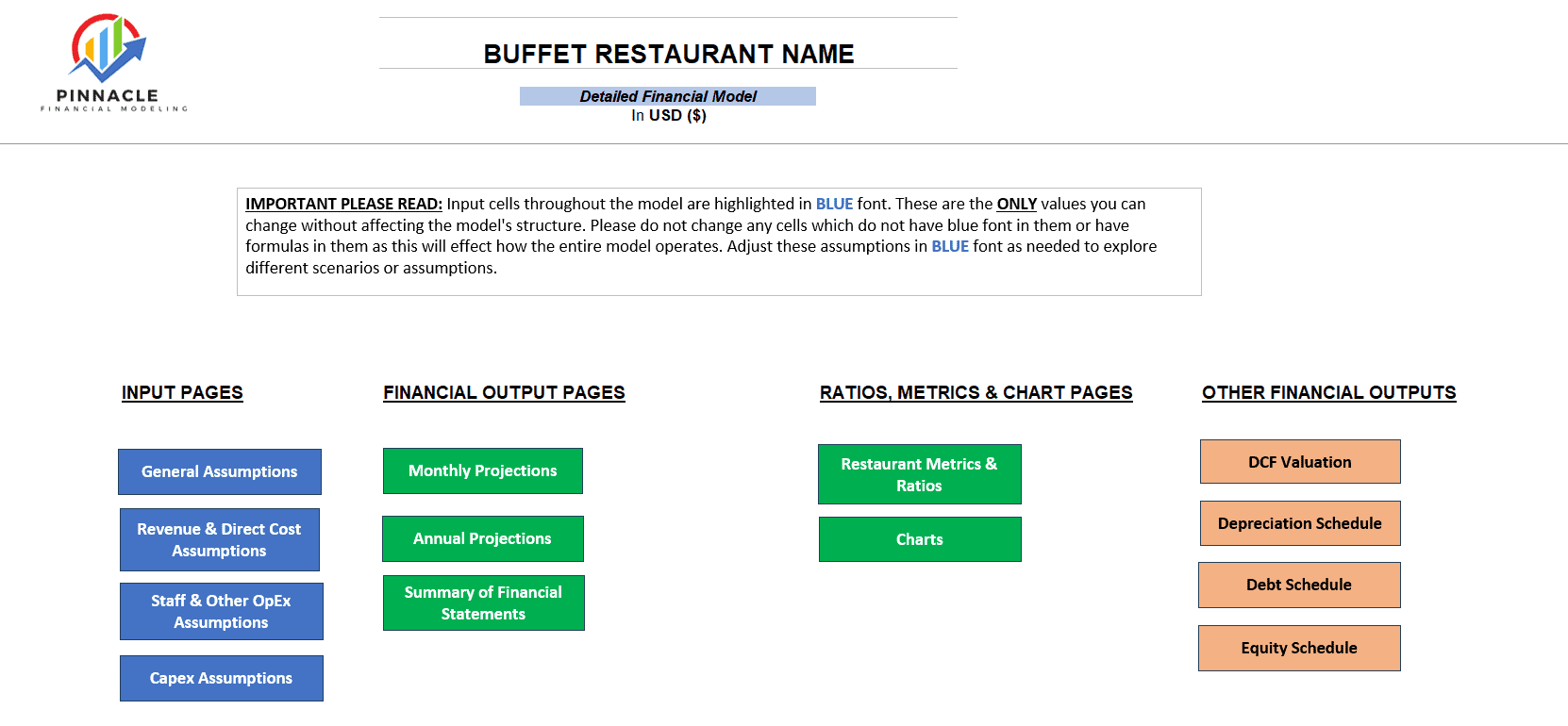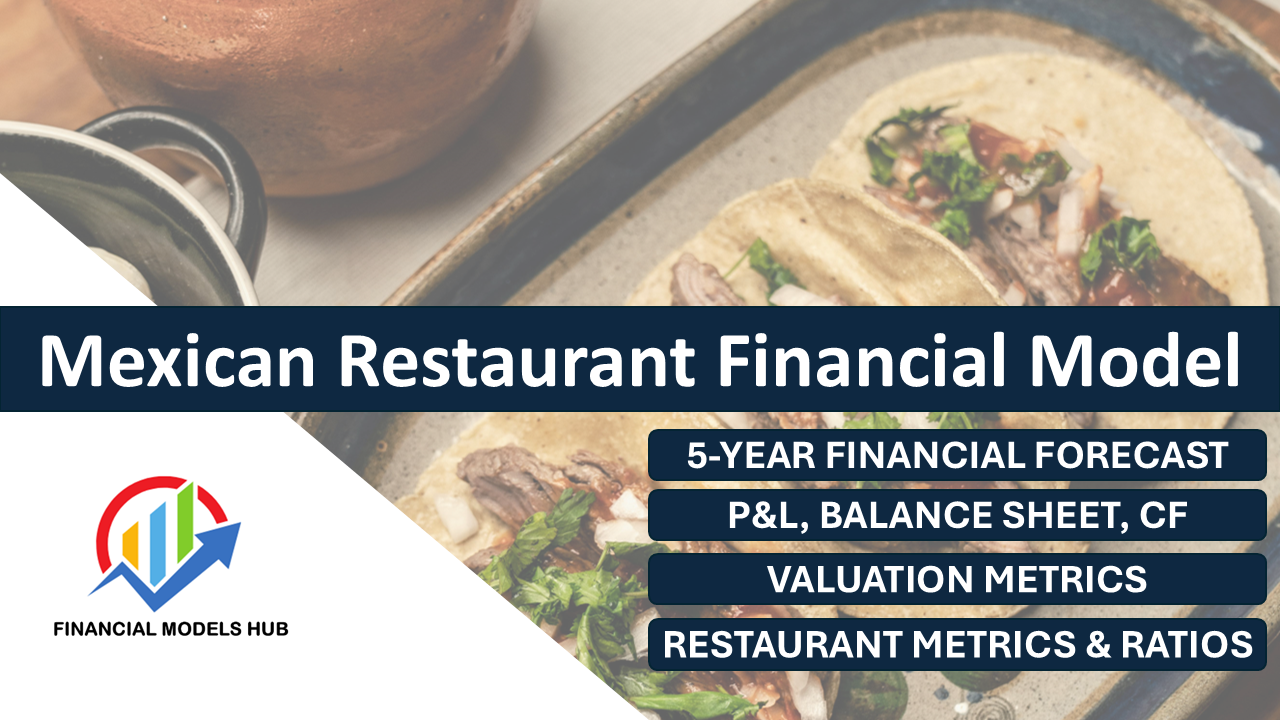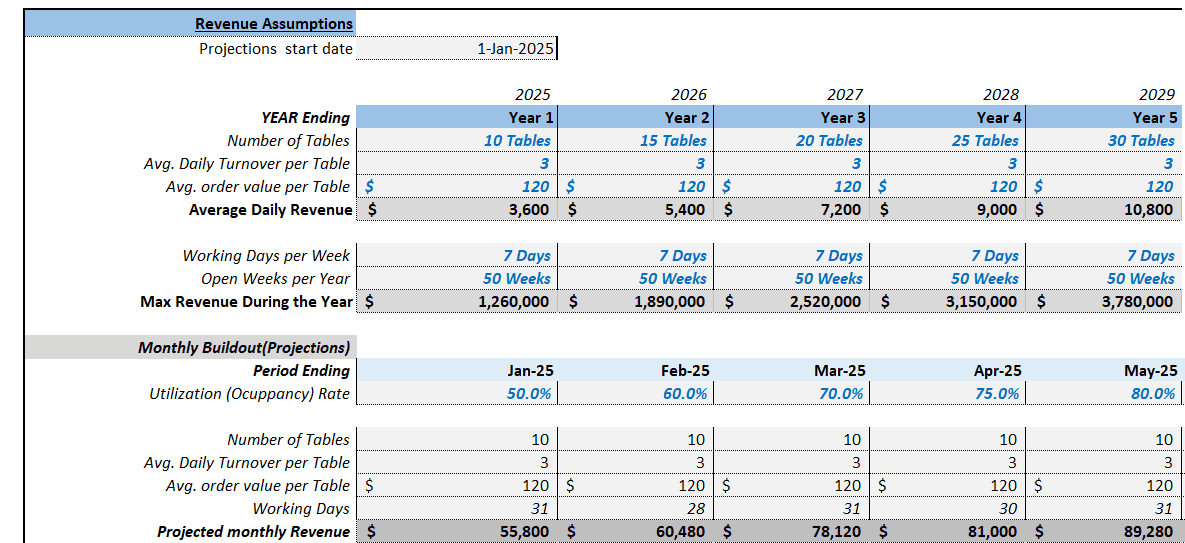This Coffee Shop Financial Model Template has been built for use by any company founder or executive in the Coffee Shop space, Investors or Analysts looking at researching Coffee Shop businesses or Students looking to study how a Coffee Shop Business operates and the key variables underpinning it. Featuring specific Coffee Shop metrics you can track (Total # of Coffees Sold (by type – Cappucino, Flat White, Mocha, Espresso, Americano, Macchiato), Average Price Per Coffee, Total Coffee Beans Sales, Overhead Rate, Coffee Beans Costs as at % of Revenue and more), users will easily be able to navigate the model with all input fields highlighted in Blue font. These models are designed to be the perfect financial tool for business owners to use to make decisions for their company and also to provide to investors to give a snapshot of how the business is currently performing and what the forecasts look like.
General Assumptions
Starts with basic model questions on start date of the model, tax rate assumption, working capital assumptions and funding assumptions.
Revenue and Direct Costs Assumptions
Revenue assumptions are the anticipated factors that drive a company’s income generation over a specific period. These assumptions form the basis for financial projections and are crucial for planning and decision-making. In our model we have included Coffee Shop specific inputs on # of Coffees Sold by Coffee Type including Cappucino, Flat White, Mocha, Espresso, Americano, Macchiato. $ Price Per Coffee Type and growth % in both # of Coffees Sold as well as Pricing growth also included. Assumptions also included for Coffee Bean packets sold in the coffee shop as well as Take-Away Food sales (croissants, bagels, toasted sandwiches, muffins). The Main Direct Costs of the Coffee Shop include Coffee Bean costs and Food costs. We have modeled both as a % of Revenue in order for you to track your input costs and make sure your gross margins are sufficient. Direct Labour we have chosen to include as Staff costs given Baristas are likely to be full time employees rather than part time, though this can also be changed if there are part time employees. Simply include Direct Labour in the Direct Cost line.
Operating Expenses Assumptions
Operating expense assumptions are typically based on historical data, industry benchmarks, market trends, and management’s judgment. They are crucial for estimating the total cost of running the business and for determining profitability. Like revenue assumptions, it’s important to regularly review and adjust operating expense assumptions to reflect changes in the business environment and ensure the accuracy of financial forecasts. In our model we have included detailed inputs on Staff Costs (Coffee Shop Manager and Barista are the primary staff costs we have included). Other typical Coffee Shop related Operational Expenditure items are included including Utilities, Rent, Insurance, Marketing and Advertising, Maintenance and Repairs, Equipment Leasing, Licenses and Permits, Cleaning Supplies and Services, POS Technology costs, however, you can add any other expenses you think may be relevant to your business in this sheet.
Capex Assumptions
Capital expenditure (Capex) assumptions refer to the anticipated investments a company plans to make in long-term assets, such as property, plant, equipment, and technology, over a specific period. These assumptions are crucial for financial planning, budgeting, and forecasting, as they impact the company’s cash flow, profitability, and growth prospects. We have included a Fixed asset cost assumption schedule here for the main items likely to be on a company’s capex sheet and also a Use Of Funds assumption list with corresponding pie chart.
Monthly Projections
We have broken down projections on a Month by Month basis when projecting Income Statement, Balance Sheet and Cash Flow Statement items. The monthly projections are provided over a 5 year time frame. This is particularly useful for businesses looking at month-on-month trends and insights in the business, which leads to better decision making and also better budgeting should there be a need to either raise more capital, pursue growth opportunities from excess capital or pay down interest bearing debt. Monthly projections also help a business ascertain what performance may be seasonal in nature when looking at growth projections on a month-over-previous-year’s-month basis.
Annual Projections
The model has Annualized Financial Projections of Income Statement, Balance Sheet and Cash Flow Statement over a 5 year time frame. Annual projections provide an excellent overview of expected revenues, expenses, profits, cash flow, and other key financial metrics for the upcoming year. Annual projections are essential for strategic planning, budgeting, fundraising, and performance evaluation for any company at any stage of their business cycle.
Summary of Financial Statements
Summarized Financial Statements over a 5 year time frame helps for better snapshots of financial performance. Income Statement, Balance Sheet and Cash Flow Statement all provided.
Metrics & Other KPI
Coffee Shop specific metrics (Total # of Coffees Sold (by type – Cappucino, Flat White, Mocha, Espresso, Americano, Macchiato), Average Price Per Coffee, Total Coffee Beans Sales, Overhead Rate, Coffee Beans Costs as at % of Revenue), Profitability Ratios, Liquidity Ratios, Asset Turnover Ratios provided.
Charts
Coffee Shop specific Charts available including Average Price Per Coffee, Profitability Margins (Gross Profit Margin, EBITDA Margin and Net Profit Margin), Revenue vs Direct Costs Projections and Cashflow Summary.
DCF Valuation
We have included a Discounted Cash Flow (DCF) Valuation model showing the Net Present Value (NPV) of the Business based on a series of growth rates and assumptions. Weighted Average Cost of Capital Assumptions also provided including Risk Free rate, Beta, Risk Premium and Equity Risk Premium. A DCF valuation is a method used to estimate the value of an investment, business, or asset by discounting its expected future cash flows to present value. It is based on the principle that the value of an investment is determined by the present value of its future cash flows. The DCF valuation technique is widely used in finance, investment analysis, and corporate finance for making investment decisions, determining the fair value of securities, and evaluating the worth of businesses.
Depreciation Schedule
Detailed Depreciation Schedule shows additions / disposals to the Fixed Asset Register of the business. Sections included for Coffee machines, Furniture & Fittings, POS System, Others.
Debt Schedule
Debt schedule provided with interest rate assumptions and payback period assumptions included.
Equity Schedule
Equity schedule provided with assumptions on all investments into the business by investors or owners.











































Katherine M –
So glad I came across this model as it has helped me so much in seeing how my coffee shop is forecasted to grow. Perfect for any owner looking for a tool they can use with all the metrics you want to track
Bonnie –
Perfect ! love this model !
Carlos –
So simple to use and understand my business thank you for this it made difference to me and my shop